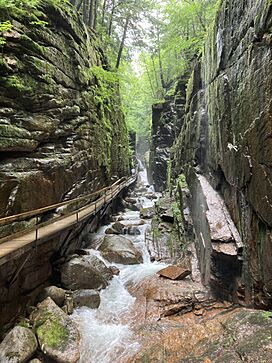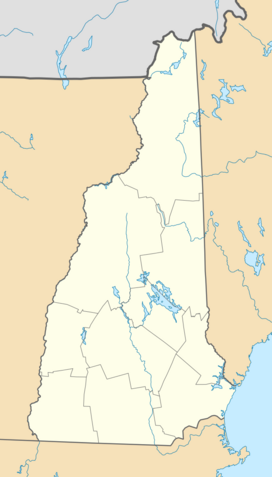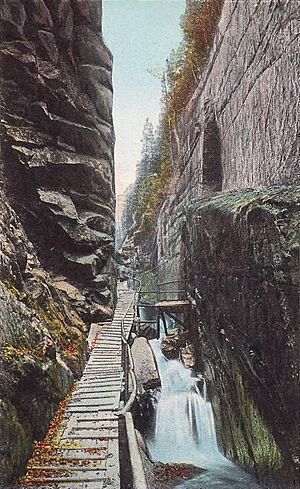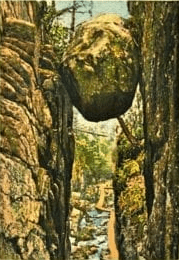Flume Gorge facts for kids
Quick facts for kids Flume Gorge |
|
|---|---|
| The Flume | |

Flume Gorge in July 2023
|
|
| Length | 800 feet (240 m) E-W |
| Width | 12–20 feet (3.7–6.1 m) |
| Depth | 70–90 ft (21–27 m) |
| Geology | |
| Type | Gorge |
| Geography | |
| Country | United States |
| State | New Hampshire |
| District | Grafton County |
| Traversed by | Flume Gorge Trail |
| River | Flume Brook |
The Flume Gorge, also known as The Flume, is a stunning natural gorge in Franconia Notch State Park, New Hampshire, United States. It stretches about 800 ft (240 m) (244 meters) at the bottom of Mount Liberty. This amazing place was carved out by Flume Brook.
The gorge has tall walls made of a type of rock called Conway granite. These walls reach heights of 70 to 90 ft (21 to 27 m) (21 to 27 meters). They are also quite narrow, only 12 to 20 ft (3.7 to 6.1 m) (3.7 to 6.1 meters) apart. A 93-year-old woman named "Aunt" Jess Guernsey first found the Flume in 1808. Today, it's a popular spot where visitors can walk through and explore. The Flume is usually open from May 10 to October 20 each year. Remember, pets are not allowed inside the gorge.
Contents
How the Flume Gorge Was Formed
The Ancient Rocks of Flume Gorge
Long, long ago, nearly 200 million years in the past, the rocks that make up the Flume Gorge were very different. The Conway granite walls you see today started as hot, melted rock deep underground. This was during the Jurassic period, a time when dinosaurs roamed the Earth!
As this melted rock slowly cooled, it formed granite. During this cooling, many thin, vertical cracks appeared in the rock. These cracks mostly ran in a northeast direction. Later, a different kind of melted rock, called basalt, pushed its way into these cracks.
Basalt Dikes and Erosion
The basalt came from deep inside the Earth. It was a fluid material that squeezed into the granite cracks due to immense pressure. The basalt cooled quickly against the colder granite, making it a very fine-grained rock. If this basalt had reached the surface, it would have flowed out as lava.
Over millions of years, the Earth's surface slowly wore away, a process called erosion. This erosion exposed the basalt that had filled the cracks. As the rock above was removed, the pressure on the granite lessened, causing horizontal cracks to form. Water could then seep into these new cracks.
Glaciers and Flume Brook's Work
The basalt dikes eroded much faster than the tough granite around them. This created a deepening valley where the Flume Gorge is now. During the Ice Age, huge sheets of ice covered the area. These glaciers didn't change the gorge's shape much. They mostly filled the valley with glacial debris and cleared away soil.
After the Ice Age ended, Flume Brook began flowing through the valley again. The brook's water, along with frost, continued to erode the fractured granite and basalt. As you walk through the gorge, you might still see parts of the basalt dike on the floor. Small trees even grow on the gorge walls! This shows that erosion is still happening today.
The Discovery of the Flume
The Flume Gorge was first discovered in 1808 by a woman named "Aunt" Jess Guernsey. She was 93 years old at the time and found the gorge by accident while she was fishing. It was such an amazing sight that she had trouble convincing her family about it. Eventually, she persuaded them to come and see the marvelous place for themselves.
The Hanging Boulder
When Aunt Jess discovered the Flume, there was a huge, egg-shaped boulder stuck between the gorge walls. This rock was about 10 ft (3.0 m) (3 meters) high and 12 ft (3.7 m) (3.7 meters) long. It looked like it was hanging in the air!
However, a very heavy rainstorm in June 1883 caused a landslide. This powerful landslide swept the giant boulder from its spot. The boulder has never been found since. That same storm also made the gorge deeper and helped create the beautiful Avalanche Falls that you can see there today.
See also




